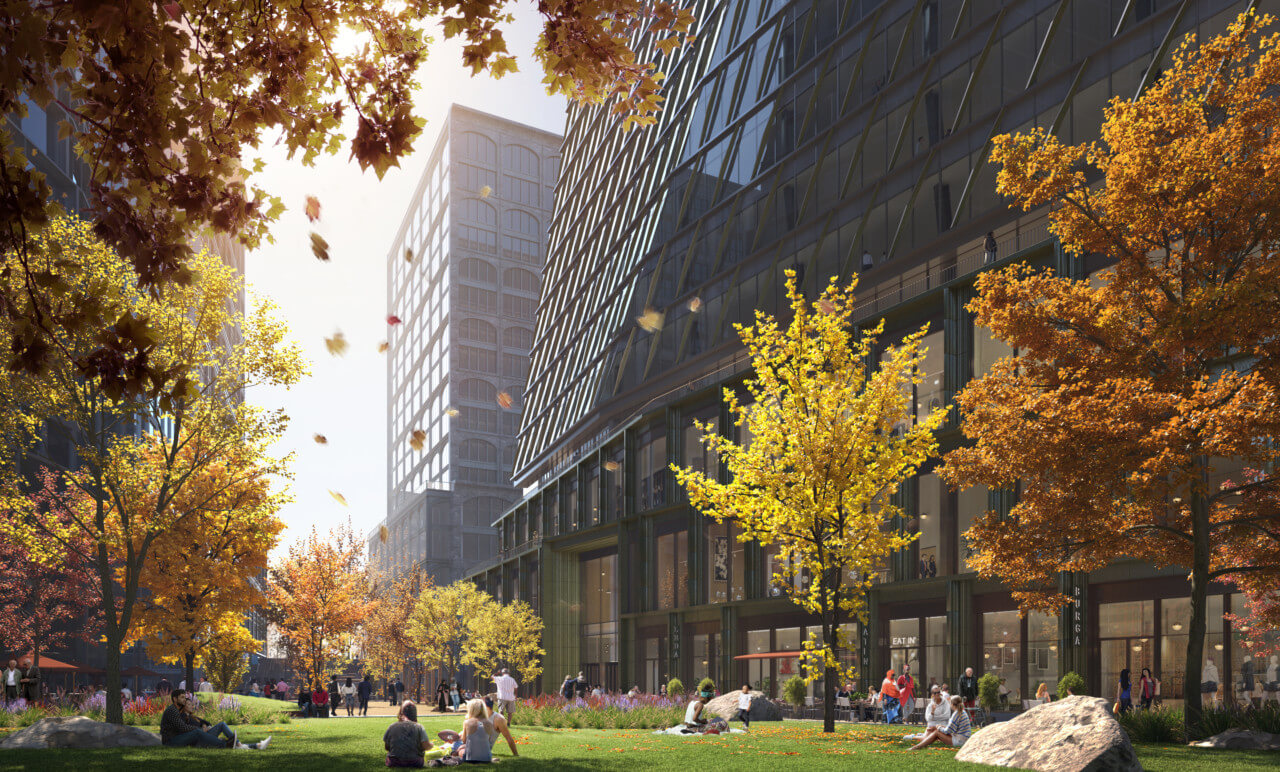No urban neighborhood in the country has grown as fast as Boston’s Seaport District. What ten or 15 years ago were parking lots have been replaced by office towers and mixed-use blocks, with more on the way. The district hums day and night with office workers, condo owners, and tourists.
But there’s been severe criticism of the quality of the architecture in the Seaport. WS Development has done substantial work in the district, and is seeking to raise the architectural bar going forward by working with firms like OMA, Morris Adjmi Architects, Gensler, Henning Larsen, and others. (The entire Seaport was financed and subsidized by public money to the tune of about $22 billion.) A few pocket parks are scattered about the mostly clunky buildings, but up until now the area lacked a unifying urban gesture. Harbor Way, a linear park featuring native New England flora and incongruous granite boulders, is just such a gesture. A third of a mile long, the pedestrian promenade cuts through the dense site to connect the harbor waterfront to Summer Street, a crucial Boston thoroughfare.
“This park is for all of Boston,” said Yanni Tsipis, WS’s senior vice president of development, at an opening ceremony held in mid-October for the central green, known as the Rocks at Harbor Way. “We worked with all the development agencies in Boston and the city was immensely supportive of the project.”
James Corner, whose New York–based firm, James Corner Field Operations (JCFO), was behind Harbor Way’s design, was also in attendance. He spoke eloquently about the parallels between the “raw, visceral nature” of Northern England, where he grew up, and New England, whose forests he has come to know intimately since buying a Cape Cod home 30 years ago. “It’s this collision between urbanity and a sense of the New England wilderness,” he said of Harbor Way.
It’s an apt summary of the park environs. Framed by trees and retail storefronts and terminating at the water’s edge, Harbor Way aspires to be a kind of Las Ramblas, Barcelona’s famed promenade. But industrial touches recalling the maritime activity that once happened here set it apart—as do those boulders. Plopped down on the green, the giant rocks (weighing 250,000 pounds altogether and sourced from regional quarries) allude to an ever-older, geological timeline. “We like the idea of landscape design that is varied,” Corner said.
He also showed sensitivity toward critiques of the Seaport. “For me it’s all about the ground plane,” Corner told AN. “I really don’t care about what the buildings are doing. The footprints of the buildings are important because it’s between them that placemaking happens. Planting a few trees in residual, leftover space is not placemaking.”
Corner’s involvement in the district goes back several years. In 2015, WS tapped JCFO and the local office of NADAAA to develop a master plan, which was subsequently picked up and altered by Sasaki (with continued input from the other two firms). This plan, approved two years later, called for developing 23 acres of land through 7.6 million square feet of office, hotel, and residential properties. Building works are expected to wrap in 2024.
In his remarks, Tsipis indicated how the earlier plan allotted substantially more area for roadways than for pedestrians. Indeed, the strip of land that became Harbor Way had originally been designated as hard top. “With the revised master plan, we said, ‘This is 2017. Why are we building roads?’”
Similar environmental concerns shaped the design of Harbor Way. The promenade, whose last stretch has yet to be completed, integrates permeable surfaces and abundant native plantings. It also reduces the urban heat island effect by creating a significant mature tree canopy in the heart of the district.
At the park unveiling, beautiful early fall weather set a festive mood. Dogs sniffed and barked about, children climbed the boulders, and adults mingled and exchanged congratulatory greetings. “This is a win for the city of Boston,” Tsipis said.
